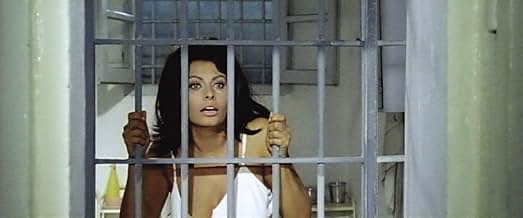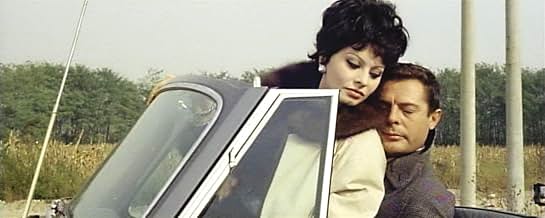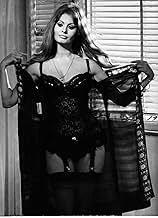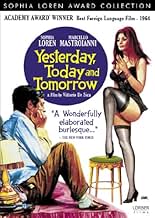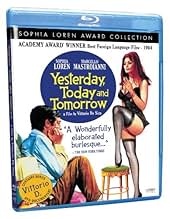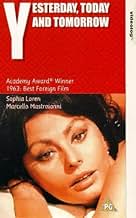IMDb RATING
7.2/10
11K
YOUR RATING
Stories about three very different women and the men they attract.Stories about three very different women and the men they attract.Stories about three very different women and the men they attract.
- Won 1 Oscar
- 8 wins & 3 nominations total
Tonino Cianci
- (segment "Adelina")
- (as Antonio Cianci)
Gianni Ridolfi
- Umberto (segment "Mara")
- (as Giovanni Ridolfi)
Featured reviews
Marcello Mastroianni and Sophia Loren star in three stories about - well, men and women - in "Yesterday, Today, and Tomorrow," a Vittorio de Sica film.
The stories vary, with the two stars playing roles that show off their different talents. All three of the stories showcase one of Loren's great talents - her awe-inspiring beauty.
I was lucky to have seen this in Italian with subtitles. The Italian language is so beautiful. I loved hearing it spoken and to see the Italian scenery along with it.
The first story is about a woman who keeps getting pregnant to avoid going to prison for not paying for furniture she purchased. She ends with 7 kids and a husband so worn out he can barely walk. Meanwhile, with each birth, she becomes more beautiful. It's either the longest story or it went on the longest - it's not the most interesting of the three.
The second story involves a rich woman with no regard for anyone but herself and her money, even though she talks a different game entirely to her new boyfriend as they're driving. She keeps bumping into people with her car. When she lets the boyfriend drive, he crashes the car rather than a hit a child, and she has a fit. A real nasty piece of work.
The third story is really the best - Loren is a high-class prostitute who befriends a young man studying for the priesthood. He's staying with his vicious grandmother in the apartment across from hers. The grandmother flings insults at Loren. Meanwhile, one of Loren's steadies, Mastroianni, can't get to first base with her because she's so distracted. This vignette is famous for Loren's hot striptease, which she repeats for Mastroianni again in 1994's "Pret a Porter." Marcello Mastroianni and Sophia Loren are excellent in all of their roles, set against the beauty of the Italian locales. Loren is gorgeous, in fact, beyond gorgeous, particularly in the last sequence. Even today, she manages to dazzle. There's something about her that no American actress can even approximate.
This film may have been a little overrated in its day, but it is certainly well worth seeing.
The stories vary, with the two stars playing roles that show off their different talents. All three of the stories showcase one of Loren's great talents - her awe-inspiring beauty.
I was lucky to have seen this in Italian with subtitles. The Italian language is so beautiful. I loved hearing it spoken and to see the Italian scenery along with it.
The first story is about a woman who keeps getting pregnant to avoid going to prison for not paying for furniture she purchased. She ends with 7 kids and a husband so worn out he can barely walk. Meanwhile, with each birth, she becomes more beautiful. It's either the longest story or it went on the longest - it's not the most interesting of the three.
The second story involves a rich woman with no regard for anyone but herself and her money, even though she talks a different game entirely to her new boyfriend as they're driving. She keeps bumping into people with her car. When she lets the boyfriend drive, he crashes the car rather than a hit a child, and she has a fit. A real nasty piece of work.
The third story is really the best - Loren is a high-class prostitute who befriends a young man studying for the priesthood. He's staying with his vicious grandmother in the apartment across from hers. The grandmother flings insults at Loren. Meanwhile, one of Loren's steadies, Mastroianni, can't get to first base with her because she's so distracted. This vignette is famous for Loren's hot striptease, which she repeats for Mastroianni again in 1994's "Pret a Porter." Marcello Mastroianni and Sophia Loren are excellent in all of their roles, set against the beauty of the Italian locales. Loren is gorgeous, in fact, beyond gorgeous, particularly in the last sequence. Even today, she manages to dazzle. There's something about her that no American actress can even approximate.
This film may have been a little overrated in its day, but it is certainly well worth seeing.
Two great performers of the Italian screen, Marcello Mastroianni and Sophia Loren, star in this earthy three-episode film, directed by Vittorio De Sica and tailor-made for the two stars. The success of this film led to the making of MARRIAGE, Italian STYLE a year later. In the first of the three comic vignettes Sophia is a black marketeer in Naples who discovers that a pregnant woman cannot be put in jail and so tries to maintain perpetual pregnancy. Poor fatigued husband Mastroianni is barely up to the task, however, and this fact provides much of the humor. The middle episode, the least effective, has Loren as a Milanese rich-bitch of liberal attitudes but who likes to plow into other people's cars. In the last episode Sophia is a Roman prostitute, Mastroianni is her sex-crazed customer. Part of the story is about how she unwittingly almost destroys the vocation of a seminarian living in an apartment across the terrace. Seminarians, surrender!
Addendum: in 2005 a new DVD release in letterbox format allows us to see the movie in its original wide-screen CinemaScope ratio. It has the original Italian language version with an English-tract option and a subtitle option.
Addendum: in 2005 a new DVD release in letterbox format allows us to see the movie in its original wide-screen CinemaScope ratio. It has the original Italian language version with an English-tract option and a subtitle option.
1963's "Yesterday, Today and Tomorrow" was, like the previous year's "Boccaccio 70," another anthology feature, this time featuring Sophia Loren with her most frequent leading man, Marcello Mastroianni, starring in all three stories for director Vittorio De Sica. In "Adelina" they are a married couple living in a poverty stricken section of Naples, where she must dodge arrest for nonpayment on furniture by way of pregnancy; "Anna" finds her a bored socialite wed to an often absent industrialist who ultimately chooses wealth over love to Mastroianni's disappointment; and in "Mara" she plays a high priced call girl who vows to spend a week without sex to convince the young man next door to follow the call of the priesthood. Her final reel striptease remains the stuff of legend but is quite tame today, the actress considering it a most pleasing, natural performance. As a 1963 Oscar winner as Best Foreign Film it was a huge success, with both stars reuniting with De Sica for their next picture, "Marriage Italian Style."
There is such a delightful playfulness to this trio of tales about relationships between men and women in Italy. Sophia Loren is in three different roles – a poor mother in Naples who keeps getting pregnant and having children to postpone being jailed for failing to pay debts on her furniture, a rich woman in Naples who has had a one-night stand while her husband is away at a conference and has picked him up the following day in her Rolls-Royce, and a high-class courtesan who does business out of her apartment overlooking Piazza Navone in Rome, attracting the attention of a young man studying to be a priest. I wouldn't say Loren has exceptional range, but she does turn in a solid performance, and plays feisty, haughty, seductive, angry, and bemused pretty well, all while being quite entertaining. Marcello Mastroianni is her counterpart in each tale (one of the clients in the last, not the young man), and is similarly engaging. It was nice to see him so light on his feet as he moved around in that last tale; his expressions were over-the-top (in a good way), and it was funny to see him ask Loren to dress up as a schoolgirl, and then watch her reaction.
The movie feels quintessentially Italian, as the characters are animated and highly expressive. There is also a feeling of genuine humanity and community. There is an honesty here, as each of the stories quite openly acknowledges sexual urges in both men and women as being natural and a positive thing, which is quite refreshing. At the same time, it remains decent and acknowledges a sense of higher morality. In the first tale, Loren's character is tempted but does not sleep with her brother-in-law when her husband can't get her pregnant again, accepts going to jail, and talks to the prisoners there without an ounce of judgment about why they're there. In the second, Mastroianni's character realizes how shallow Loren's is when she's more concerned about damage to her car after they nearly run over a child. In the third, Loren's character realizes that despite an antagonistic relationship with the young man's grandmother (played fantastically by Tina Pica), she has common ground with her, and must persuade the boy to stay on his path. How nice it is that director Vittorio De Sica shows us that these things – lust and morality – can exist side by side, perfectly well.
The movie feels quintessentially Italian, as the characters are animated and highly expressive. There is also a feeling of genuine humanity and community. There is an honesty here, as each of the stories quite openly acknowledges sexual urges in both men and women as being natural and a positive thing, which is quite refreshing. At the same time, it remains decent and acknowledges a sense of higher morality. In the first tale, Loren's character is tempted but does not sleep with her brother-in-law when her husband can't get her pregnant again, accepts going to jail, and talks to the prisoners there without an ounce of judgment about why they're there. In the second, Mastroianni's character realizes how shallow Loren's is when she's more concerned about damage to her car after they nearly run over a child. In the third, Loren's character realizes that despite an antagonistic relationship with the young man's grandmother (played fantastically by Tina Pica), she has common ground with her, and must persuade the boy to stay on his path. How nice it is that director Vittorio De Sica shows us that these things – lust and morality – can exist side by side, perfectly well.
These three stories very "Italian" indeed, are full of good humour, social observation and correct atmosphere. The direction of De Sica is superb, the acting of Mastroianni and Loren is unique and in the second and third stories we recognize the subtle and superior hand of their author, the great Zavattini. The first story takes place in a very typical popular neighbourhood of Naples where a cigarette pedlar and smuggler (Sofia Loren) discovers that the way of not going to jail for failing to pay a fine, is to get pregnant over and over and giving birth to one child after another with the problems this brings to her exhausted husband (Mastroianni). The second story shows us an aristocratic Milanese rich lady who to escape her boring life gets herself a lover on a social stratum lower to hers and finishes by valuing her Rolls Royce car more than her lover. This is perhaps the not so good of the three stories because it lacks some strength in terms of plot. Finally the third story (maybe the best of the three) is sometimes delirious and hallucinating in its very funny rhythm (Loren's acting is fabulous here) and tells us about a luxury prostitute living near the Piazza Navona in Rome who nevertheless has a soft heart and with whom a neighbour young seminarist falls in love while she plays a game of pull and let go with one of her clients who is anxious to take her to bed most unsuccessfully. This story has a surprising end and a fascinating scene of strip-tease (incomplete of course). You'll have a very amusing time watching this movie.
Did you know
- TriviaThe red car that picks up Mara after the accident is an extremely rare 1960 Ferrari 250 GT California Spyder SWB. Only 56 of these cars were made and some have sold for over $10M at auction in the 2010's.
- GoofsAs Anna and Renzo talk while driving, the windshield of her Rolls-Royce Silver Cloud II shakes because the little side windows are gone, but the little side windows are intact in the wide shots.
- Quotes
Carmine Sbaratti: The people of Forcella are out of this world. They've risen up in a gesture of solidarity!
Verace's sister: I must say, it almost makes you forget how filthy and ignorant they are.
- ConnectionsEdited into Marcello, una vita dolce (2006)
Details
- Release date
- Countries of origin
- Language
- Also known as
- Yesterday, Today and Tomorrow
- Filming locations
- Piazza Navona, Rome, Lazio, Italy(3rd part - Mara's apartment)
- Production companies
- See more company credits at IMDbPro
- Runtime1 hour 58 minutes
- Sound mix
- Aspect ratio
- 2.35 : 1
Contribute to this page
Suggest an edit or add missing content

Top Gap
By what name was Hier, aujourd'hui et demain (1963) officially released in India in English?
Answer


